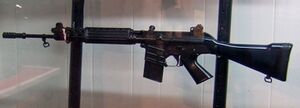Engineering:FN CAL
| FN CAL | |
|---|---|
 FN CAL on display at the National Firearms Museum, United States . | |
| Type | Assault rifle |
| Place of origin | Belgium |
| Service history | |
| Used by | See Users |
| Wars | Vietnam War Colombian conflict Gaza-Israel conflict Internal conflict in Myanmar The Troubles Lebanese Civil War Tuareg rebellion (1990–1995) |
| Production history | |
| Designer | Ernest Vervier |
| Designed | 1963–66 |
| Manufacturer | FN Herstal |
| Unit cost | (FY2022) $820 |
| Produced | 1966–1975 |
| No. built | Approx. 30,000 |
| Specifications | |
| Mass | 3.35 kg (7.385 lbs) |
| Length | 980 mm (38.58 in) |
| Barrel length | 467 mm (18.4 in)[1] |
| Cartridge | 5.56×45mm NATO |
| Action | Gas-operated, rotating bolt |
| Rate of fire | 850 rounds/min |
| Feed system | 20-, 25-, or 30-round detachable box magazine |
| Sights | Iron sights |
The CAL (Carabine Automatique Légère, Light Automatic Carbine) was a Belgian assault rifle manufactured by Fabrique Nationale. It was the first 5.56 mm rifle produced by the Fabrique Nationale. It resembled the company's highly successful FN FAL, but was an original design. Unlike the FAL, it was a market failure, although its development led to the more successful FN FNC.
Design details
Prior to the development of the CAL, FN had already constructed a scaled-down FAL prototype before shelving the idea as unmarketable. Noting the growing sales success of the cheaper and simpler HK G3 rifle, FN decided that for any future rifle to be competitive in the marketplace, it would need to use fewer expensive precision-machined parts. These would be replaced by less expensive castings and stampings where possible. While the construction of the new CAL reflected these design principles, it was still relatively expensive and complex, and met with no significant sales. It was eventually dropped for the even less expensive FN FNC.[2] A small number of FN CALs were sold to the civilian market in the US.
Operation
Although the weapon resembled a scaled-down FN FAL, it in fact used a rotating bolt, unlike the FAL, which used a tilting bolt design. The earlier models of the CAL had a three-round selector system, which allowed the weapon to fire a three-round burst with each trigger pull. The CAL could also fire in fully and semi-automatic modes.
The gun used long stroke gas piston to operate the bolt carrier, and the bolt itself had interrupted lugs to lock it into the chamber.[3] Locking lugs were cut diagonally at a steep angle. So while the bolt is rotating to unlock, bolt face is slowly moving back, giving primary extraction of the case. Similar feature can be seen on MG 30, MG 15, MG 17 and MG 34.
Users
 Belgium
Belgium Myanmar: Karen National Liberation Army[4]
Myanmar: Karen National Liberation Army[4] Colombia[4]
Colombia[4] Gabon[5]
Gabon[5] Provisional Irish Republican Army[6]
Provisional Irish Republican Army[6] Lebanon: Lebanese Forces[5]
Lebanon: Lebanese Forces[5] Mali: People's Movement for the Liberation of Azawad[7]
Mali: People's Movement for the Liberation of Azawad[7] Morocco: Gendamerie Royale[8]
Morocco: Gendamerie Royale[8] Palestine[9][4]
Palestine[9][4] Thailand: Royal Thai Police
Thailand: Royal Thai Police
For trials
- Template:Country data Pahlavi Iran: Tested the CAL for consideration to the Imperial Iranian Army, but was never adopted.[10]
 France: Tested the CAL in the late 1960s and early 1970s for military adoption. It had a MAS-49/56 style rifle grenade launching system. But was never adopted. [11]
France: Tested the CAL in the late 1960s and early 1970s for military adoption. It had a MAS-49/56 style rifle grenade launching system. But was never adopted. [11]
See also
- FN FAL, 7.62mm NATO predecessor
- FN FNC, successor
- List of assault rifles
References
- ↑ "FN CAL.". Weaponsystems.net.. Archived from the original. Error: If you specify
|archiveurl=, you must also specify|archivedate=. https://web.archive.org/web/20230305005225/https://weaponsystems.net/system/179-FN+CAL. - ↑ Kokalis, Peter G. (December 1985). "FNC; Belgium's Compact Carbine". Soldier of Fortune Magazine. Archived from the original. Error: If you specify
|archiveurl=, you must also specify|archivedate=. https://web.archive.org/web/20230214205255/https://remtek.com/arms/fn/fnc/index.html. - ↑ Hogg, Ivan V.; Weeks, John S. (2000), Military Small Arms of the Twentieth Century (7th ed.), Krause Publications, https://archive.org/details/militarysmallarm0000hogg
- ↑ Jump up to: 4.0 4.1 4.2 "FN CAL around the world - The FAL Files". http://www.falfiles.com/forums/showthread.php?t=395072.
- ↑ Jump up to: 5.0 5.1 Jones, Richard D. Jane's Infantry Weapons 2009/2010. Jane's Information Group; 35 edition (January 27, 2009). ISBN:978-0-7106-2869-5.
- ↑ Clarke, Lism, M. Kathryn, Johnston (2001) (in en). Martin McGuinness: From Guns to Government. Mainstream. ISBN 9781840184730. https://books.google.com/books?id=wapnAAAAMAAJ&q=FN+CAL+.
- ↑ Small Arms Survey (2005). "Sourcing the Tools of War: Small Arms Supplies to Conflict Zones". Small Arms Survey 2005: Weapons at War. Oxford University Press. p. 166. ISBN 978-0-19-928085-8. http://www.smallarmssurvey.org/fileadmin/docs/A-Yearbook/2005/en/Small-Arms-Survey-2005-Chapter-06-EN.pdf.
- ↑ "wiw_af_morocco (worldinventory)". 2010-02-12. http://sites.google.com/site/worldinventory/wiw_af_morocco.
- ↑ "Belgian FN Herstal CAL rifle in Gaza". Armament Research Services (ARES). Archived from the original. Error: If you specify
|archiveurl=, you must also specify|archivedate=. https://web.archive.org/web/20230414160815/https://armamentresearch.com/belgian-fn-herstal-cal-rifle-in-gaza/. - ↑ "Iranian 5.56mm Rifles: From S5.56 to Masaaf – Silah Report". Archived from the original. Error: If you specify
|archiveurl=, you must also specify|archivedate=. https://web.archive.org/web/20230305005228/https://silahreport.com/2021/09/15/iranian-5-56mm-rifles-from-s5-56-to-masaaf/. - ↑ Huon, Jean (2010) (in French). Le FAMAS et son histoire. Crépin-Leblond Éditions. p. 43. ISBN 978-2-70-300336-6. https://crepin-leblond.fr/armes-d-epaule/607-le-famas-et-son-histoire-9782703003366.html.
 |

